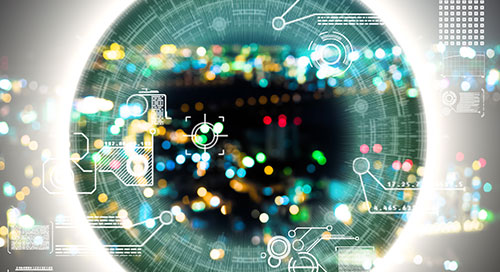Fast-Track Computer Vision at the Edge

Computer vision, real-time analytics, and AI are showing up in applications you might not expect. Robots are just one example. Some use these technologies to clean office buildings from top to bottom. They navigate around obstacles, take the elevator, and self-dock to recharge.
Smart factories, city safety, retail, and healthcare applications all present opportunities for IoT developers focused on these segments.
And many have found that the Intel® Movidius™ Myriad™ VPU streamlines computer vision applications. Designed to lower barriers to entry for developers seeking to deploy deep learning and AI at the edge, Movidius is a self-contained AI accelerator. And when combined with the Intel® Distribution of OpenVINO™ Toolkit, software development efforts are greatly reduced.
Movidius technology allows computer vision processing to be performed at the edge, using just 1 watt of power. It was developed specifically for on-device computer vision, high-quality image processing, and deep neural network applications. This allows developers to handle vision-centric tasks in smart devices—and provides scalability from single- to multi-chip solutions.
On Logic Inc. designs industrial computers and works with developers—helping them build embedded computer vision solutions. The company specializes in using the smallest amount of computing resources to solve customer-specific OT and IT needs.
Johnny Chen, Solutions Architect at OnLogic, explained the company’s approach to working with developers.
“Computer vision enables organizations to collect, analyze, and act on massive amounts of data in new ways,” says Chen. “Let’s say a stadium installs 50 cameras for producing data to maximize pedestrian flow and improve security. Using graphics processing units (GPUs) for edge analytics consumes a huge amount of power. And that’s very expensive.”
GPUs were designed for computer games, not AI and computer vision. Movidius VPUs can process data using far less energy to run vision analytics. The processors also save in other ways. “Imagine the bandwidth cost if that stadium uploaded streaming video from 50 cameras to the cloud for analysis,” Chen added.
That enormous amount of video data can also be used to improve machine learning. The stadium with 50 edge devices uses a model to establish traffic pattern parameters and determine when they’ve been exceeded. Data is processed locally and the results are sent back to the cloud. But that same data can be used to inform adjustments to the model itself, creating a learning loop for automation. And this allows the system to become smarter and more efficient over time.
Machine Learning at the Edge
While Movidius streamlines machine learning, the OpenVINO™ toolkit makes it easier for developers to run deep learning inference using pre-trained models. They can perform this at the edge as well as in traditional computer vision solutions.
Chen described the toolkit’s efficiency regarding application portability, pointing out that programmers can write one version of their code and model: “They can pick a processing unit—CPU, GPU, or VPU—or use what’s optimized. Any of these in any combination, without having to re-code.”
Computer Vision Algorithms in the Extreme
Another advantage of using Movidius is that developers can deploy edge devices in small spaces—even harsh conditions that include extreme temperature ranges, dust, vibration, and water.
“Debris floating around factories makes computers with cooling vents impractical. For instance, a factory that works with carbon fiber or metal creates airborne particulate that can easily enter fanned systems and fry the boards,” says Chen. “That’s why we design compact, fanless, and ruggedized computing devices that can be cooled passively without the need for openings in the enclosure.”
Chen commented that customers frequently over-spec their designs. “Often we can help clients achieve the functionality they need by matching them with a more efficient component combination,” he says. “We also help reduce power consumption—a major cost when large numbers of units are deployed. It’s another compelling reason to use embedded systems.”
In addition, a major benefit of developing high-performance, compact designs for extreme conditions is that it helps IoT computing become far more cost-effective.
Smart Cities and Computer Vision
Computer vision at the edge can make cities more livable. One use case is rapid, cost-effective pothole detection. “Garbage trucks drive a regular route,” says Chen. “Why not mount a camera on them and write a model that recognizes potholes?”
Computer vision can even improve cities and infrastructure yet to be built. For instance, pedestrian traffic flow data collected in existing subway stations can be analyzed to design new ones that optimize the placement of entrances, gates, tunnels, overpasses, and other fixtures.
“Subway stations are like shopping malls,” says Chen. “But if a kiosk—let’s say where commuters pick up breakfast—is placed in the wrong location, lines can block access to the ticket vending machines.” By building a model that compares data from well- and ill-planned subway stations, it’s easier to design even more efficient ones.
Real-World Partnerships
With its strong Intel® partnership, Logic Supply brings real-world applications based on powerful technology. “Every day we speak with our customers about their current challenges—input that we share with Intel,” says Chen. “We are a bridge between Intel and its customers—helping deploy embedded computer vision solutions at the edge, across a wide range of use cases.”
With IoT deployments, each customer needs a custom solution. Chen summed it up: “One of the keys to our success, and the success of the industry is that we don't make generic computers. We make specialized devices to effectively and reliably accomplish specific tasks.”
This article was edited by Christina Cardoza, Associate Editorial Director for insight.tech.
This article was originally published on September 12, 2019.